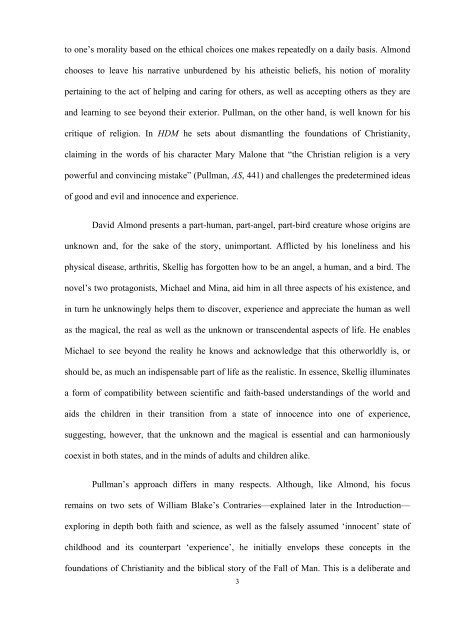The secular angel in contemporary children's literature: David ...
The secular angel in contemporary children's literature: David ...
The secular angel in contemporary children's literature: David ...
You also want an ePaper? Increase the reach of your titles
YUMPU automatically turns print PDFs into web optimized ePapers that Google loves.
to one’s morality based on the ethical choices one makes repeatedly on a daily basis. Almond<br />
chooses to leave his narrative unburdened by his atheistic beliefs, his notion of morality<br />
perta<strong>in</strong><strong>in</strong>g to the act of help<strong>in</strong>g and car<strong>in</strong>g for others, as well as accept<strong>in</strong>g others as they are<br />
and learn<strong>in</strong>g to see beyond their exterior. Pullman, on the other hand, is well known for his<br />
critique of religion. In HDM he sets about dismantl<strong>in</strong>g the foundations of Christianity,<br />
claim<strong>in</strong>g <strong>in</strong> the words of his character Mary Malone that “the Christian religion is a very<br />
powerful and conv<strong>in</strong>c<strong>in</strong>g mistake” (Pullman, AS, 441) and challenges the predeterm<strong>in</strong>ed ideas<br />
of good and evil and <strong>in</strong>nocence and experience.<br />
<strong>David</strong> Almond presents a part-human, part-<strong>angel</strong>, part-bird creature whose orig<strong>in</strong>s are<br />
unknown and, for the sake of the story, unimportant. Afflicted by his lonel<strong>in</strong>ess and his<br />
physical disease, arthritis, Skellig has forgotten how to be an <strong>angel</strong>, a human, and a bird. <strong>The</strong><br />
novel’s two protagonists, Michael and M<strong>in</strong>a, aid him <strong>in</strong> all three aspects of his existence, and<br />
<strong>in</strong> turn he unknow<strong>in</strong>gly helps them to discover, experience and appreciate the human as well<br />
as the magical, the real as well as the unknown or transcendental aspects of life. He enables<br />
Michael to see beyond the reality he knows and acknowledge that this otherworldly is, or<br />
should be, as much an <strong>in</strong>dispensable part of life as the realistic. In essence, Skellig illum<strong>in</strong>ates<br />
a form of compatibility between scientific and faith-based understand<strong>in</strong>gs of the world and<br />
aids the children <strong>in</strong> their transition from a state of <strong>in</strong>nocence <strong>in</strong>to one of experience,<br />
suggest<strong>in</strong>g, however, that the unknown and the magical is essential and can harmoniously<br />
coexist <strong>in</strong> both states, and <strong>in</strong> the m<strong>in</strong>ds of adults and children alike.<br />
Pullman’s approach differs <strong>in</strong> many respects. Although, like Almond, his focus<br />
rema<strong>in</strong>s on two sets of William Blake’s Contraries—expla<strong>in</strong>ed later <strong>in</strong> the Introduction—<br />
explor<strong>in</strong>g <strong>in</strong> depth both faith and science, as well as the falsely assumed ‘<strong>in</strong>nocent’ state of<br />
childhood and its counterpart ‘experience’, he <strong>in</strong>itially envelops these concepts <strong>in</strong> the<br />
foundations of Christianity and the biblical story of the Fall of Man. This is a deliberate and<br />
3
















